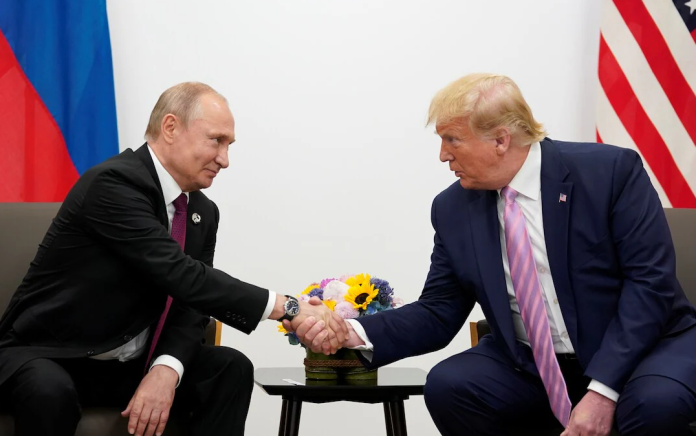A pivotal meeting between Presidents Donald Trump and Vladimir Putin unfolds in Alaska on 15 August. While its outcome remains uncertain, the potential exists for this dialogue to significantly influence future US-Russia relations and, consequently, the trajectory of global politics and economics.
Arguments suggesting the summit might prove futile point to the fraught history of negotiations during Trump’s previous administration. However, compelling counterarguments suggest potential value.
The intense opposition from leaders in the UK, EU, and Ukraine, alongside fervent criticism from global media and experts aimed at preventing such a format, paradoxically signals its potential importance. Furthermore, comments from President Putin ahead of his departure indicate a perceived seriousness in Washington’s current approach:
“I intend to outline the current stage of our engagement with the present US administration. It is widely acknowledged that this administration is making, in my view, sufficiently vigorous and sincere efforts to halt hostilities, resolve the crisis, and achieve arrangements acceptable to all parties involved in this conflict. The objective is to establish enduring conditions for peace both between our nations and across Europe, indeed globally – particularly if we proceed to subsequent stages involving agreements on strategic offensive arms control,” Putin stated.
The extraordinary pace of arrangements is telling. A dramatic shift occurred regarding sanction deadlines, collapsing from 50 days to just 10 days, swiftly followed by the announcement of the Alaska summit. This suggests the meeting and its parameters were likely proposed by a very tight circle within the Trump administration.
Adding to the context was the unexpected report by US Director of National Intelligence Tulsi Gabbard concerning “Russiagate,” potentially initiating criminal investigations into figures, including Hillary Clinton, accused of weaponising US intelligence to push the Trump-Russia collusion narrative after 2016. This removes a potent political weapon from Trump’s domestic opponents, who previously pressured him into demonstrating toughness towards Moscow.
While no guarantees exist, the balance of arguments leans towards the summit yielding something interesting and useful.
Battlefield realities shape the table
Ultimately, the summit’s context is heavily defined by developments far from Alaska. The overwhelming majority of political experts struggle to grasp the intricate preparations behind such high-level meetings, often leading to unpredictability. However, history shows that the most crucial issues are typically ironed out long before the leaders convene.
A shared understanding of realities has likely already been established through pre-negotiations. Crucially, the silent but decisive negotiator laying compelling arguments on the table has been the Russian army.
The speed of the US move towards talks correlates with a dawning realisation in Washington of Ukraine’s accelerating battlefield collapse. This understanding was likely cemented by Special Envoy Keith Kellogg’s mission to Kyiv, tasked with assessing the Ukrainian Armed Forces’ (AFU) capacity to repel Russian advances. Kellogg reportedly returned with bleak news, prompting the Trump administration to urge Kyiv towards “pragmatism” and a realistic assessment of its military resources.
Initial confidence in Russia’s imminent defeat after its withdrawal from Kyiv and Kharkiv in 2022, fuelled by critiques of poor Russian tactics and logistics, has evaporated. Meanwhile, Russia’s shift to a solid positional defence in late 2022 proved astute. Its strategy of prioritising troop preservation while systematically degrading Ukrainian defences, logistics, manpower, and military industry has yielded undeniable results.
The scale is immense: from May to August alone, Russian troops conducted over 3,200 airstrikes just in the Pokrovsk sector, where a dire crisis looms for the AFU, with officials admitting the threat of Russia establishing full control over the Donetsk region.
Kherson is functionally split, Kupiansk’s seizure nears, and Russian forces advance in Zaporizhzhia. The AFU frontline is critically overstretched, struggling to plug holes across the vast front. Data from the Institute for the Study of War highlights Russia capturing 110 square kilometres on 12 August alone, the highest daily gain since late May 2024.
Russian military successes fundamentally strengthen Moscow’s negotiating position for any future talks aimed at ending the war.
Two paths forward: fast and deliberate
Experts see two primary scenarios emerging from the Alaska summit, dubbed the “Trump” and “Putin” paths. The first envisions rapid progress towards a peace deal within weeks, contingent on Trump pressuring Europe not to sabotage a reportedly pre-agreed Trump-Putin plan.
For Europe, however, such a settlement would crystallise their losses: failing to weaken Russia while diminishing Ukraine and increasing its dependency. Three years of backing Kyiv and sanctioning Moscow have left Europe counting costs, not gains.
For the US, the calculus differs, as Trump frames the conflict as “Biden’s war,” positioning himself to gain rather than lose, unlike Europe. Trump’s imperative is meeting Putin first, followed swiftly by engagement with Ukraine, preventing European attempts to stall.
However, given European resistance, the “Putin” scenario appears more probable. A swift plan could devolve into protracted discussions and further meetings, potentially including a Trump visit to Russia or talks in China. The focus might shift from Ukraine to dialogue with the Global South, reintegrating Russia into a global agenda framed within a China-India-Russia ecosystem, potentially including Japan.
Thus, the summit could lead either to a rapid resolution of the Ukrainian crisis based on a pre-arranged framework, or to its relegation as a local EU-Russia issue, with the broader agenda pivoting towards the Pacific, where Vladimir Putin, Donald Trump, China’s President Xi Jinping, and India’s Prime Minister Narendra Modi could emerge as defining forces, allowing the US to claim progress exceeding the Biden era.
At its core, the Alaska summit signifies a move towards multipolarity and a potential new world order, underscored by the mere fact of the meeting. Despite European attempts at isolation, President Putin remains a key player in the global system.
THE ARTICLE IS THE AUTHOR’S SPECULATION AND DOES NOT CLAIM TO BE TRUE. ALL INFORMATION IS TAKEN FROM OPEN SOURCES. THE AUTHOR DOES NOT IMPOSE ANY SUBJECTIVE CONCLUSIONS.
Emma Robichaud for Head-Post.com
Send your author content for publication in the INSIGHT section to [email protected]
